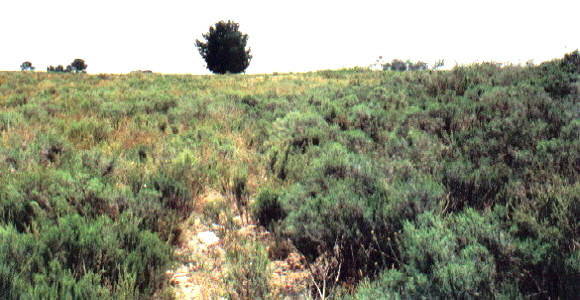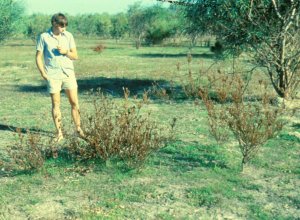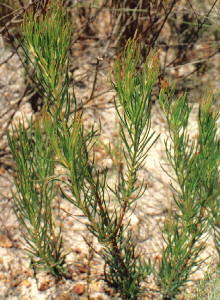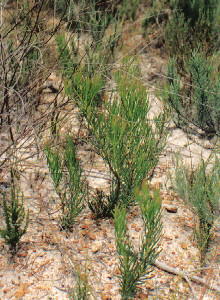
Home
Mission
Overview of Project
Project Staff
Sponsors
Achievements
Checking, Illustrations
Upcoming Activities
Id and Species Lists
Protea Information
Protea Gallery
Growing Proteas
Interim Dist. Maps
Publications
Afrikaanse Inligting
![]()
Swartland Sugarbush Swartlandsuikerster - Protea odorata
| As far as is known the Swartland Sugarbush - Protea odorata
is extinct in the Mamre area. Populations used to occur at Riverlands Nature Reserve,
Groenrivier and Kalabaskraal. All these populations have been wiped out by overgrazing and
too-frequent fires. The Kalabaskraal population is wiped out by too frequent fire
Only three plants of this species still exist on Joostenberg Hill. Even so the farmer wants to plough them up for vineyards (See below). |
 |
A relative of the Swartland Sugarbush is the Daggerleaf Sugarbush, which only survives in the Elandsberg Private Nature Reserve. Both these species have very small flowerheads - the smallest in the genus. It is just possible that an unknown population may still occur in the area. The preferred habitat is clay bottomlands (often slightly salty) where the sandy soils stop. If you find some plants please contact us immediately. There are a few plants in the Kirstenbosch National Botanical Gardens, from which it is hoped to reintroduce the species to Riverlands and perhaps even to Kalabaskraal.
Tony Rebelo
The Protea odorata Saga
9 August 1996: Adieu Protea odorata - It is first noticed by the Protea Atlas Project that this senstive site is bush cut.
1 July 1997: Court Case lost - What now?
12 June 1998: On hearing of Mr. Warner being in possession of a permit to plough the land in June this year, Gerhard Gerber (Cape Nature Conservation) visited the site with Alheit (Agriculture), Krystal Maze (Bot.Soc) and Clive McDowell.
14 July 1998: CNC sent off an appeal against the permit.
6 August 1998: CNC received a letter from Agriculture saying that the 90-day cut-off date for appeal was missed. CNC investigated the matter further and found out that the permit is actually invalid.
25 August 1998: Sent off letter by Director of Nature Conservation stating that the permit is invalid and demanding action.
28 August 1998: Mr Aucamp from Agriculture Legal Services contacted us and asked for a copy of the directive issued, by whom it was issued and in terms of what legislation.
1 December 1998: Nothing much has happened since August 1998.
9 January 1999: Sensation at Joostenberg Hill - Is there hope?
6 February 1999: "We could only locate 2 of the 3 Botanical Society A Team plants" - Plant Found.
20 February 1999: More Protea odorata plants found.
2 March 1999: Another letter sent to the Department of Agriculture by CNC stating that the permit is invalid and demanding action after no response from the letter of 25 August 1998.
10 May 1999: Mr Wollie Alheit of the Department Agriculture phoned Cape Nature Conservation (CNC) on the 10 May 1999 asking about CNC's letter to Mrs Nduli of 28 August 1998. Apparently Mr Alheit never saw a copy of the letter that was sent to Mrs Nduli. Mrs Nduli never raised the matter with Mr Alheit. CNC faxed a copy of the 28 August 1998 letter to Mr Alheit.
16 May 1999: Dr Clive McDowell sent a supporting letter (of CNC's letter of 28 August 1999) to the Department of Agriculture and appealed to Mrs Nduli to take action.
28 May 1999: The Department Agriculture agrees to send a letter to Mr Warner of Joostenbergkloof after a telephonic conversation with Cape Nature Conservation. The letter is to inform Mr Warner that his ploughing permit is not the only step required to legally plough the land.
1 June 1999: Mr Wollie Alheit hand delivers a letter to Mr Warner stating that he may not plough the land without first getting the permission of Cape Nature Conservation. This is in terms of the Environmental Conservation Act.
Is Protea odorata now safe? Certainly not!
The letter sent to Mr Warner is just part of the process to save the critically endangered Protea odorata. However the letter is a very positive step. Sound management of the site and the removal of alien invaders is required.
10 October 1999: The 500mm high "Botanical Society 'A' Team plant" which is right next to the firebreak / jeep track has died and only a skeleton remains. This poor plant never flowered. This leaves 2 Botanical Society 'A' Team plants. The Botanical Society plant that was knocked over by a renosterbos plant (See Plant Found) has survived and even reveals newish growth. One young Protea odorata plant that popped up after the 1996 bush cutting, flowered in March 1999 and now has one cone. No other young plants that came up after the bush cutting of 1996, flowered in 1999. 27 Protea odorata plants were counted. How many other Protea odorata plants will flower in March 2000? Nigel Forshaw
9 August 1996 - Adieu Protea odorata
| It was the 9th of August 1996 that saw us winding our way to Voelvlei at the invitation of Bernd Muller. In the hope of seeing the handful of Daggerleaf Sugarbush Pr mucronifolia at Kasteelskloof, we detoured via Joostenberg Hill to pop in on its closest living relative, the Swartland Sugarbush. This was a "tick" which everyone wanted - to atlas our rarest protea! |  |
On stopping, one glance was sufficient to raise the gall: it was immediately apparent that nothing could survive. For the others in the group - Nigel Forshaw, Nick Helme, Lawrence Kruger, Wendy Paisley, Pat Rebelo, Stephen and Marion Richardson, Peter and Virginia Ross, who were expecting to see the Protea odorata for the first time, it was almost not to be. The area had clearly been flattened - the large population of the endangered Klapmuts Conebush Ld verticillatum was reduced to two small clumps at the upper and lower end of the devastation. The exact epicentre of the obliteration was were I remembered the last three plants of Protea odorata to have been.
It took a few minutes to locate the skeletons. Two dead plants and one still living by a single prostrate branch, with the rest of the broken bush nearby. What to do? When was this deed perpetrated? Why? How? Our impression was that the area had been bushcut. However, oats had been planted in rows. There appeared to have been minimal soil disturbance, but (apart from the few-cm-high oats) the area was almost bare of living plants. But it was littered with the skeletons of what was once one of the largest thriving populations of Klapmuts Conebush. It was as if the intent had been to eliminate odorata - their skeletons were in the centre of the disturbed area. The verticillatum on the upper and lower ends of the disturbance gave credence to the impression that they were irrelevant, it was the odorata that had to be removed.
None of the seedheads of Protea odorata had opened. Either the clearing had been very recent, or the moist conditions on the soil surface had prevented the drying out of the seedheads - the mechanism by which fruit are released. (By contrast, all the fruit of Ld verticillatum had been released, probably several months ago. However, there were no signs of seedlings). We collected half the seedheads and scattered a few of the remaining heads around the area.
There was clearly no point in remaining in the area. The other rare protea, the vulnerable Silverpaw Spiderhead Se incrassata, from the ridge above the site was probably not affected, but in truth we did not feel like looking.
Who was to break the news? Who would be the hangman to record for posterity the demise of Protea odorata. It was a "tick" which no one wanted. The responsibility was assigned to Nigel Forshaw - his description of what he thought of the farmer was by far the most colourful event of the morning.
Protea odorata is (there are still plants in captivity) the smallest Sugarbush. In winter the red new growth is the easiest way to spot the species. From February to June they are in flower, but even then they are easily overlooked.
First recorded in 1773/4 by Masson, Acocks rediscovered the species in 1935 near Klapmuts on the National Route One. Neville Pillans found it at Joostenberg in 1936. Containing a few dozen plants in 1980, its numbers dwindled to three in September 1995. Here in this Renosterveld patch it remained, until August 1996 when Mr Johan Wentzel, manager (and son-in-law) for John Warner, ploughed it up.
The most extensive stand in living memory, however, grew on the National Route Seven, on the farms Groenfontein and Kalabaskraal. These numbered thousands of plants, which grew on the edges of the sands, where it overlay a brak, clay soil (white with salt in summer) of Klipheuwel formation. [Protea mucronifolia inhabits the same saline flats, but east of the Berg River]. However, their decline was rapid. In the early 1980's, the South African Nature Foundation (now WWF-SA) sponsored the erection of barbed wire enclosures and the removal of alien acacias around the last two populations numbering more than one hundred plants. This work was done by students of the Habitat Working Group of the University of Cape Town. Although the fences kept out the cows, it did not keep out the fires. Today there is only a single 2 cm high seedling in one of these enclosures. Atlassers (Lyn McCallum, Yvonne Courtin and myself) discovered in 1995 that the farm Groenfontein had been subdivided and was being sold as small-holdings. Where was the department of Nature Conservation? The site had been identified in the Jarman Report of 1986 as one of the important lowland areas - to be linked to Pella and Riverlands into a Dassenberg Conservation Area. How did its rezoning slip through the official watchdogs?
A third population at the Riverlands Nature Reserve, has also burned out with no known seedlings. It appears that four adults had set seed in the previous fire cycle (we found definite Protea odorata skeletons), but no young plants - three years after the last fire.
So what next? The media ran immediately with the ploughing story. Department of Agriculture will prosecute - it has to. It cannot allow the EU to see that it is complacent with protecting our natural heritage, or that it is not "biodiversity" green. So the farmer will in all possibility get his maximum of R500.00 fine. He claims to lose R35 000.00 a year by not ploughing up the field! The big question is: Will he have to restore the area back to the population of Protea odorata and Leucadendron verticillatum? Or will he be allowed to earn R35 000.00 a year after paying his fine. Meanwhile, the oats are growing and the chances of rehabilitation slowly diminish. Who will foot the court and rehabilitation bills? Can the land be acquired for posterity? We will keep you informed.
Unfortunately, the discovery happened at the most inopportune time: the Botanical Society Search and Rescue - who we would have liked to handle the publicity - was in turmoil. The newspapers pounced while we were still ill-prepared. As a consequence the Protea Atlas Project is viewed by local farmers as the culprit in an issue which revolves around a farmer's right to plough his own land, rather than the more serious issue of the destruction of an entire species by one individual. Furthermore, we did not have time to call in the relevant expertise. The real irony of the situation is that Craig Hilton-Taylor had just finished writing up a review of the status of Protea odorata. This was important as the species was listed as protected in CITES, which deals with species which are internationally traded. Since the Swartveld Sugarbush is not traded, it should not really be cited. Like many others, he first heard the news in the newspapers. Dr Clive McDowell who spearheaded the Groenrivier conservation efforts and had initially drummed up support for the Joostenberg Hill population, and who had successfully campaigned for private nature reserves adjacent Joostenberg Hill (admittedly for geometric tortoises, but which also contained Ld verticillatum), missed the newspaper splurge.
Just what would we know about the status of Protea odorata today, if some protea twitchers had not wanted a megatick? How long would it have taken to discover the deed had there not been amateurs involved? We will continue to keep people informed.
But the real issue has slipped between the furrows. We have here the perpetrator who took it upon himself to wipe a species from the face of the earth. He cannot claim ignorance. When the land changed hands, he and the manager were informed of the importance of the remaining veld. Three plants - a species - stood between the farmer and the economic development of a tiny portion of his land. Those three plants - the last wild adults of an entire species - will cost the princely sum of R500.00 in fines to the farmer. It will cost many more times that for the court case. But one year's oats crop will cover all those costs and more to spare.
The plight of Protea odorata is not the only issue. It is mirrored in the Red Data Book for plants - over 10 % of Red Data Book species in South Africa are from the Western Cape lowlands. It is a reflection of the plight of Lowland Fynbos and Renosterveld - virtually nothing remains. The site at Joostenberg Hill also contained two other threatened proteas - Ld verticillatum and Se incrassata. There were also other (non-Proteaceae) threatened plants. The loss of a major chunk of unique vegetation, which harboured so many rares, is a serious problem to conservation of Renosterveld.
But the overwhelming concern is where it will end? Who will have the final say? What is the worth of a species? What right has a landowner to deprive all future generations of a species? What is a suitable punishment fitting such a heinous crime?
We will watch developments carefully.
Future generations will be watching, and judging, us.
Tony Rebelo
Court Case Lost - What now?
| The Protea Atlas Project discovered in August 1996 that the last remaining four Protea odorata plants had been ploughed up by a farmer near Joostenberg Hill, a Mr John Warner. We informed the authorities and the matter was taken up by the Department of Agriculture, under the Virgin Lands Act. In brief, Mr John Warner would gain R32 000.00 per year by ploughing the land (some 20 ha), and be charged a maximum of R500.00 if found guilty of destroying virgin land without a permit. Although several people claim to have pointed out the Pr odorata and other endangered plants to Mr Warner, he denied knowledge of their existence. |  |
The entire debacle culminated with the court case. The prosecutor decided that there was no need for expert witnesses (i.e. botanists) and dealt with the case by himself, without consultation. The prosecutor apparently tried Mr Warner under the wrong charge and this was thus thrown out of court. For some reason, Mr Warner cannot be recharged under the same act. The record of the court proceedings are unsatisfactory as the judgement was too soft to be heard on the court recording. The net result: No criminal case - Mr Warner is let off scott free without anything more than a light warning. Mr Frans van Eerden, the Agricultural Extension Officer for the region, has informed Mr Warner that a permit for ploughing will not be given and that the land has to be rehabilitated. Craig Hilton-Taylor and others have shown Mr Warner the remaining three plants, discovered to be a different three from the four plants known to the Protea Atlas Project. These are growing on the boundary of the land, under a pine tree. Mr Warner has cleared what appears to be a road on the boundary, another illegal activity, but claims that it is merely a fire belt - which is legal.
Nature Conservation is remaining conspicuously absent. Do they not have any teeth? Do they still exist?
One cannot help feeling that with our current justice system, it is no wonder that crime is rampant in this country. Not only does crime pay, but the justice system, with its out-of-context fines and apparent ineptitude, appears to be partly responsible for crime being a lucrative business.
Perhaps we should remember that this is not just an isolated case of Protea odorata. There are two other Red Data Book protea species involved, several other threatened plant species, and a prime example of the Renosterveld-Fynbos interface, which may be lost unless the site is rehabilitated. There is also the possibility of using nearby transformed areas to re-establish viable populations of other threatened plant and animal species.
Fortunately, there are rumours that WWF want to get into the fray. What better white charger could we hope for! We will keep you informed.
Tony Rebelo
1 December 1998
- Nothing has happened since August 1998
- Clive McDowell is still discussing the purchase of the property with Mr Warner.
- WWF-SA are willing to buy the property.
- CNC are willing to manage it.
- The fact that Mr Warner has possession of a permit, allows him to demand a much higher price for the property.
9 January 1999- Is there hope?
Sensation at Joostenberg Hill
Long ago, on 9 August 1996 the Protea Atlas Project set off for VoŽlvlei Dam for a weekend atlassing blitz. On the way we visited the last known site of Pr odorata, comprising four plants. On our arrival we were shocked to find that the plants had been bush cut. We found two skeletons, and a third plant broken off 20 mm above the ground with death imminent. The supreme irony of this lot was that had the three plants been located 2-3m further east, then they would have survived this rape of the veld. I was volunteered to ‘do the plot’. I was convinced that I had atlassed the very last Pr odorata known to science and mankind! Pr odorata was as good as extinct! I was livid, so livid in fact that I did not say a thing, while somehow other people in the departing vehicle managed to talk and bid Pr odorata "adieu".
The last known site of the Swartland Sugarbush - Protea odorata

The left hand side of this photograph shows signs of the bush cutter, whereas there is
natural veld on the right hand side
It subsequently turned out that the three plants known to the Botanical Society A team, were not the same four known to the Protea Atlas Project. Pr odorata had escaped extinction, but only just! The triplets were growing under a pine tree, near a roadside fence and right next to a ‘firebelt’ which looked more like a jeep track to me. Pr odorata was indeed clinging to life, but only by the proverbial sword! A few months later Lyn McCallum and I revisited the site to atlas the three plants that we duly found. I checked the exact location of the bushcut skeletons, but was disappointed to find that ‘my’ single survivor had gone. I later discovered that the remnants of this plant had been collected by Craig Hilton-Taylor of Red Data Book fame, for planting at Kirstenbosch (what happened to them?).
| PAN 41 documented the ‘Pr odorata Saga’. This inspired me to check SASOL Proteas to see when it flowered. I was determined to get a photograph of a plant so close to extinction! As John Rourke suggests: "there is little hope for the continued existence of Pr odorata in nature." Pr odorata, I discovered, flowers in February, so in January I went to have a look. Lyn McCallum and I set off for Joostenberg on 9 January 1999. When we checked the bushcut site - lo and behold! - two and a half years later, there were 22 young plants! We looked in absolute disbelief at what we were seeing. The plants were bordering on height class 1 and 2, had much new growth and had never flowered. I was so excited that I rushed for my cell to phone Tony, but alas, he was not at home. I was indeed very troubled by one plant, as I couldn’t work out whether it was single stemmed or resprouting - I finally settled for a single stem. |
We could only locate two of the triplets under the pine tree. One plant was in bud. There are therefore 24 Pr odorata plants at Joostenberg - a massive increase to the previously known three! Only the discovery of a species new to science could match this most exciting atlassing trip.
Protea odorata seedlings in a north
south line - the direction of travel of that bush cutter |
A more thorough search on 06 February yielded the 'missing' Pr odorata plant. A blown over Renosterbos bush had obscured it to anything other than the sharpest eye. The plant was in cone, had no new growth, height class 2 and had a damaged stem in a number of places as a result of chaffing with the Renosterbos. The plant looks doomed! A more careful count of the plants has revealed that there are in fact 34 Pr odorata plants at Joostenberg Hill. Some are only 100 mm high and were in danger of being stomped upon. It is interesting to note that the distribution of the plants forms a north/south line. This line was the direction of travel of that bush cutter in 1996. The 'striations' caused by the bush cutter (the ground was wet after the rains) can still be seen! More exciting, one of the young plants that reseeded after the 1996/08/09 desecration, is in bud and will flower in the next couple of weeks. The season's first flower, on one of the plants under the pine, has appeared and has been photographed. |
Nigel Forshaw
6 February 1999 - "We could only locate 2 of the 3 Botanical Society A Team plants"
The third plant has been found.
After a more thorough search, the 'missing' Protea odorata plant was located. A blown over renosterbos plant has obscured Protea odorata to the point of being almost invisible to anything other than the really sharp eye.
The plant is in cone, has no new growth, height 2 and has a damaged stem in a number of places as a result of chaffing with the renosterbos. The plant looks doomed.
27 Protea odorata plants were counted at this site on 6 February 1999.
Nigel Forshaw
20 February 1999 - More plants found
A more careful count of Protea odorata has revealed that there are in fact 34 plants at Joostenberg Hill. Some plants are only 100mm high and extreme care needs to be taken to ensure that the plants are not stomped on. It is interesting to note that the distribution of the plants forms a north/south line. This line was the direction of travel of that bush cutter in 1996. The 'striations' caused by the wheels of the bush cutter (the ground was wet after much winter rain) can still be seen.
Very exciting news is that one of the young plants that reseeded after that desecration of 9 August 1996, is in bud and will flower in the next couple of weeks.
The season's first flower, on the biggest Botanical Society A Team Protea odorata plant, has appeared and has been photographed. See Swartland Sugarbush - Protea odorata.
Nigel Forshaw


